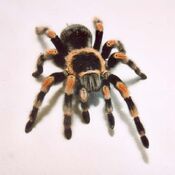
A Mexican red knee tarantula (Brachypelma Smithii).
Spiders are eight-legged arthropods. There are approximately forty thousand known species of spider. They can be found on every continent on Earth, except Antarctica, and live in almost every kind of habitat.
All known species of spiders living today are predators. Most of them live on a diet of insects or other spiders but some larger ones eat lizards or birds. Spiders' guts are not large enough for them to eat solid food, consequently they liquify their prey by injecting it with enzymes before swallowing it.
Most spiders produce silk that they shape into webs and use to catch their prey. Spider webs can vary significantly in size, shape and the amount of sticky thread used to produce them, depending on the species of spider which makes them.
People and spiders
Little Miss Muffet is frightened by a toy spider in this 1902 illustration by William Wallace Denslow.
Spiders' seeming ability to produce something out of nothing, by spinning their webs, has led them to become symbols of creation in some cultures. As a result of the time that they take in producing their webs and waiting for their prey, many cultures have also been adopted them as symbols of patience. However, the manner in which they capture their prey by surprise has led them to be seen as symbolic of mischief and wickedness in many cultures also.
Arachnophobia, the fear of spiders, is one of the most common of all phobias. According to a 1992 study, 18% of males and 55% of females in the Western world suffer from it. A famous fictional sufferer of the phobia is the title character in the English nursery rhyme "Little Miss Muffet". In the rhyme, first published in 1805, Little Miss Muffet runs away in fear when a large spider comes towards her.
The common fear of spiders has led to several horror movies being made in which monstruous spiders attack people. These movies include Tarantula (1955), Kingdom of the Spiders (1977), Arachnophobia (1990) and Eight Legged Freaks (2002). Spider webs often feature heavily in haunted house-type settings in movies and television programs. An early scene in the 1931 movie Dracula shows Count Dracula walking through an enormous spider web without breaking it.
A gigantic talking spider named Aragog features in J.K. Rowling's 1998 novel Harry Potter and the Chamber of Secrets, the second book in the Harry Potter series, and its 2002 movie adaptation. Aragog has a great number of children who are happy to eat human flesh.
Spiders' strong associations with fear mean that fake spider webs and spider-shaped decorations, made of paper, foil, wool or rubber, can often be seen at Halloween parties. Food in the shape of spiders and spider webs is often served at Halloween parties too. People dressed as witches and warlocks may carry rubber spiders as props to go with their costumes.
Although many people in the West find spiders scary, more positive images of spiders exist in Western fiction too. In E.B. White's 1952 children's book Charlotte's Web and its 1973 and 2006 movie adaptations, Charlotte the spider saves Wilbur the pig from being slaughtered by placing words that compliment the pig in her web. In Amazing Fantasy #15 from August 1962, Peter Parker is bitten by a radioactive spider and becomes the superhero Spider-Man. The spider-like abilities that Peter Parker take on are great strength, agility and a degree of extra-sensory perception.
